10+ Sample Employee Leave Schedules
-
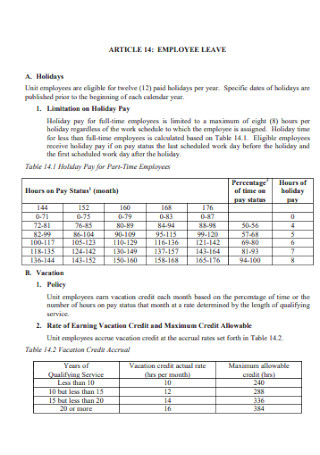
Employee Leave Schedule Format
download now -
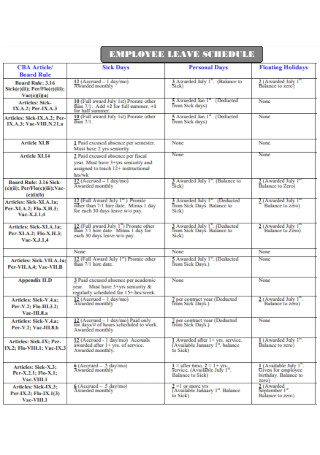
Sample Employee Leave Schedule
download now -

Employee Holiday Leave Schedule
download now -
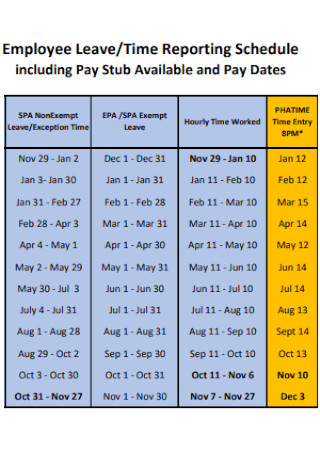
Employee Leave and Time Reporting Schedule
download now -
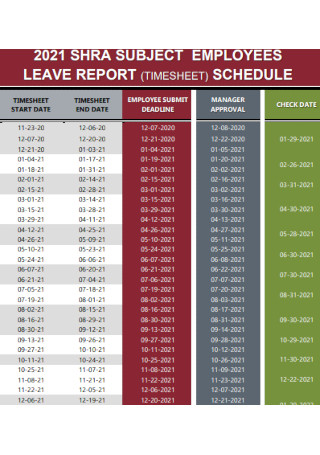
Employee Leave Report and Schedule
download now -
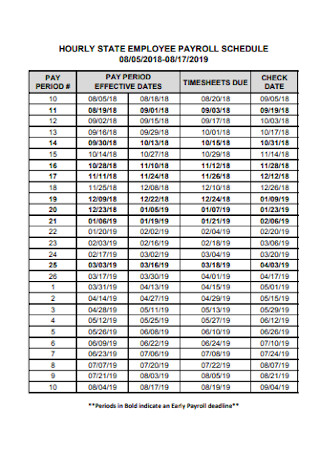
Employee Leave Payroll Schedule
download now -
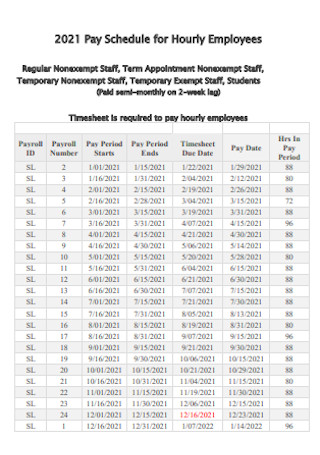
Pay Schedule for Hourly Employee Leave
download now -
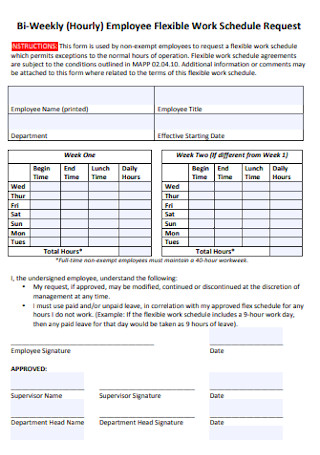
Employee Leave Flexible Schedule
download now -
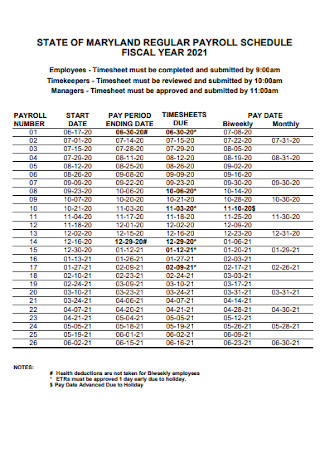
Regular Employee Leave Schedule
download now -
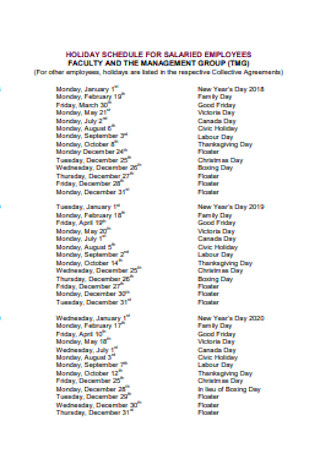
Employee Holiday Schedule
download now
FREE Employee Leave Schedule s to Download
10+ Sample Employee Leave Schedules
What is an Employee Leave Schedule?
Types of Employee Leaves
How to Create Employee Leave Schedule Template?
Effects of Paid Leaves on Employees
Managing Leave of Absence
FAQs
How can employees request a leave of absence?
How long should employees take a leave?
Is it legal for employers to require proof that the employee has a serious health condition?
Can employers approve a vacation leave but not give paid time off?
What is an Employee Leave Schedule?
Employees are entitled to a specific number of leaves per year that they can use any time within the year. According to the Bureau of Labor Statistics, employees the most common types of leaves that employees avails are vacation leaves and medical care reasons. Some employees also file a request for leave from work for personal reasons, family emergencies, or to simply take a day off. To help managers and human resources decide if they should grant the request or not, they can refer to the employee leave schedule.
An employee leave schedule is an important document that monitors and tracks filed leaves of employees. This ensures that operations and productivity are not affected when an employee files for leave from their work schedule. It helps human resources and managers prevent putting the business operations to a halt due to overlaps and simultaneous leaves of employees. Aside from vacation days, an employee leave schedule also tracks sick days filed, personal leaves, and both paid and unpaid leaves.
It can also be used to record if the leave request was for a full day leave, half-day leave, or multiple day leaves. Results can also be summarized on a monthly or yearly basis. This will allow HR and the employee to chart and track all leave balances and annotate work schedules. It provides data that can be helpful in project planning and leave management.
Types of Employee Leaves
There is no getting around it when personal issues and problems bleed into your work. Filing for a leave of absence at work is sometimes the only solution so you can face it head-on. Here are the different types of employee leaves that you may request from your employer.
How to Create Employee Leave Schedule Template?
With all these different types of leaves, it is important that employers use an employee leave schedule tracker. This tracker should be loaded with functionalities that are not just easy to understand and use, but also one that doesn’t buffer or lags. Here’s how you can create a tracker and have an effective tool for plotting your employee leave schedule in a single document.
Step 1: Use Office Software Program to House All Necessary Data
If you’re comfortable using MS Word, Excel, Google Sheets, Pages, or Numbers, then do so. Rename it to match your organization’s standard naming protocol. Once you’ve done this, prepare for data entry. Make sure that you place proper headings and titles such as days, weeks, and months.
Step 2: Enter Different Types of Leaves that You Have in Your Company
As you are creating a template, you may enter all types of leaves and absences to suit your company. Customize the names of these types of leaves with your own preferred labels. You should enter all types of leaves that are valid and credited within your organization.
Step 3: Select Company Weekends and Holidays
Though Saturday and Sunday are the most common weekends, they can vary depending on the operating hours of the company. It is also possible that employees prefer to take weekday offs and work during weekends. It is important to include this in your template to make it easier for you to compute for working days. Also, include a list of holiday planners that your company observes and set in different colors so you can view them distinctly from each other.
Step 4: Enter Employee Data
Any number of employees can be specified in the employee leave schedule template. Employee names are pulled through from their start date (date when they began employment) and the termination date (if applicable). As it is possible to manage an unlimited number of employees for an indefinite period, new employees may join the company and the current ones leave. Your template should be able to work smoothly even with all the changes in the data.
Step 5: Employee Leave Data
This section is often left blank. Once an employee requests time off, regardless of paid or unpaid, it should be entered into the database. It should reflect employee names, the start and end dates of their leave, and the type of leave that they requested.
Step 6: View Dashboard and Generate Attendance Report
Your employee leave schedule is designed in a way that allows tracking the leaves and absences of your employee. A dashboard gives you’re a glimpse of how employee attendance looks like and generating a report per month can track absenteeism as well as productivity of employees when you need it during strategic planning.
Effects of Paid Leaves on Employees
In the US, the employer is not obligated to provide mandatory paid holiday time off to their employees. However, employers choose to add these perks and benefits, and a general rule of thumb, employees are given a minimum of 10 days of paid vacation time. It may seem like a costly option, but its benefits to the company have been proven to outweigh the expense.
Research studies have shown that paid vacation leaves are good benefits for both workers and the business. It improves talent acquisition, increases their productivity and employee morale, as well as encourages engagement and retention.
Improved Morale
Work-life balance is important for employees. By giving them personal and paid time off, employers show that they value their workers and help them unwind and relax to reduce stress. This is especially helpful to those working in high-stress jobs who cannot afford to take an unpaid break. Employees feel more in control of their time and their lives if they are able to choose to take time off to do other things that matter to them such as going on a field trip with their children, visiting a loved one living away from them, or to simply rest and recharge. As a result, these employees develop positive feelings towards their work and improve their morale.
Higher Productivity
Employees with high morale tend to be happier and happy employees are more productive at work. Giving them the paid time off that they deserve gives employees the opportunities to settle personal issues at home and away from their workplace. It prevents their personal lives to bleed into their work when they need to take important personal calls and make appointments during their work hours. Consequently, the person paid vacation, as a result, reduces distractions while at work and improves their productivity.
Increased Retention Rates
One of the cost-saving benefits of employee leave benefits is increased retention rates. Retaining an employee is more cost-effective while replacing an employee is a more costly option. The recruitment process is long and takes time to hire someone from advertising to interviewing to training the new hire. Studies have also shown that turnover costs are 20% more expensive than employee retention. Giving workers this benefit of paid vacation leave also increases job satisfaction, thus making them stay and less likely to quit.
Managing Leave of Absence
Scheduling leaves and managing leave of absences of the employees are among the responsibilities of HR. It is largely a game of coordination and there are five steps that they must do in order to handle it:
- Determine applicable laws
- Review company policies and practices
- Document the process of approving or disapproving leave requests
- Take action as employee situation progresses
- Conduct ongoing evaluation of individual and organizational performance
FAQs
How can employees request a leave of absence?
Leave of absence is often requested through the human resources and immediate manager. At some companies, the employee simply asks for time off, while others require that you go through a formal process of filing for leave requests. It should be noted that outside the conditions of FMLA, employers have the right to approve or decline a leave request.
How long should employees take a leave?
It depends. Under the FMLA, eligible employees are allowed up to 12 weeks of unpaid leave but their jobs are protected and remain intact for when they go back. Local regulations also play a part in terms of paid time offs as well as company policies.
Is it legal for employers to require proof that the employee has a serious health condition?
Yes. Employers may require their employees to take a family and medical leave of absence to submit proof or verification of the existence of serious health conditions of the employee or their loved one. However, they should also be given enough time, at least 15 calendar days, to get medical certification and comply with other medical requirements.
Can employers approve a vacation leave but not give paid time off?
Yes. Under the Fair Labor Standards Act (FLSA), employers are not obliged to provide paid sick or vacation time to their employees. But many organizations provide this benefit to attract a better quality pool of candidates.
If there is one takeaway from this article, it is that: rested employees are happy and productive employees. Now that you are equipped with the knowledge about employee leave schedules and how to create one, you may start your own template from scratch or download any of the ready-made employees leave schedules from our selection.
